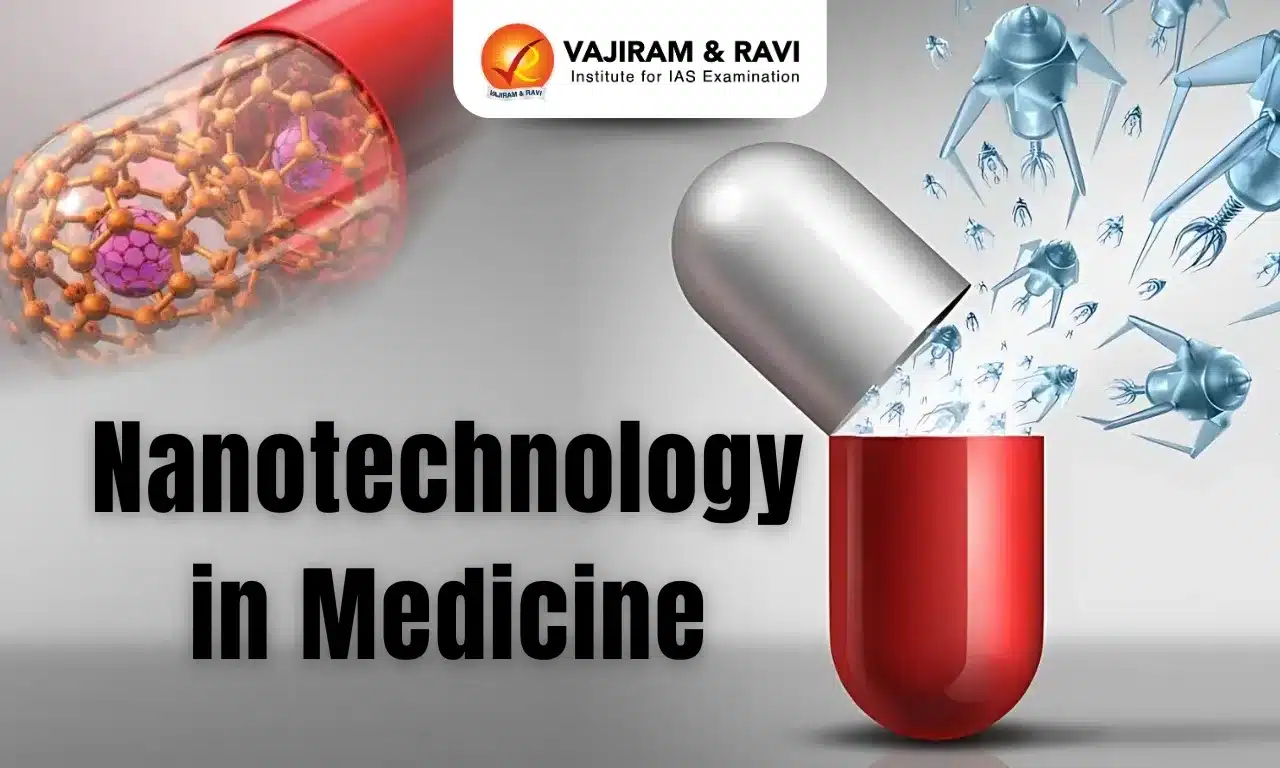Nanotechnology in Medicine employs minuscule materials and devices to revolutionize healthcare. It offers precise drug delivery, advanced disease detection, and innovative treatments, leveraging nanoparticles and nanodevices for targeted therapy and diagnosis. Nanotechnology in Medicine has also enabled rapid disease diagnosis via biosensors and lab-on-a-chip devices. Further, antimicrobial nanomaterials like nano-silver can counter antibiotic resistance. Cancer therapies using gold nanoparticles are in clinical trials.
Nano-devices facilitate minimally invasive surgeries, point-of-care diagnostics, and ultrasensitive biosensors. This cutting-edge technology holds promise for personalized medical solutions catering to individual needs.
Introduction to Nanomedicine
Nanomedicine is the application of nanotechnology in healthcare and medicine. It involves the use of nanoscale materials and devices for diagnosis, delivery of drugs and other therapeutic agents, and regeneration of tissues. The nanoscale materials have unique physical, chemical and biological properties that allow for novel medical applications. Some key advantages of nanomedicine include:
- Targeted drug delivery: Nanoparticles can be designed to carry drugs and release them at specific sites in the body, avoiding toxicity to healthy tissues improving efficacy and reducing side effects.
- Earlier detection of diseases: Nanosensors and nanoparticles can detect biomarkers associated with cancer and other diseases at very low concentrations for earlier diagnosis.
- Regenerative medicine: Nanomaterials provide scaffolds for tissue regeneration and help integrate prosthetic devices with biological tissues.
- Improved imaging: Nanoparticles carrying contrast agents allow for higher-resolution medical imaging for better diagnosis.
Applications of Nanotechnology in Medicine
Nanotechnology is revolutionizing medicine through several innovative applications that leverage the properties of materials at the nanoscale. Some key areas include:
| Application | Examples |
| Drug Delivery | - Targeted systems like liposomes, dendrimers, and micelles that can precisely deliver drugs to diseased cells while avoiding side effects, improving treatment efficacy. |
| Medical Imaging | - Advanced imaging agents like iron oxide nanoparticles for enhanced MRI contrast, quantum dots for highly sensitive fluorescence imaging, and gold nanoparticles for better CT Scan visualisation. |
| Diagnostics | - Rapid nano biosensors, microfluidic lab-on-chip devices, and nanoparticle test kits for quick biomarker and pathogen detection at point-of-care. |
| Antimicrobial Agents | - Nanoparticles like nano-silver, and nitric oxide to overcome antibiotic resistance through alternative bactericidal mechanisms. |
| Tissue Engineering | - Nanopatterned scaffolds, nanofibers, and growth factor-loaded nanoparticles to better regulate cell growth for regenerative medicine. |
| Cancer Treatment | - Targeted chemotherapy, photothermal ablation, and magnetic hyperthermia using gold/iron oxide nanoparticles. |
| Biosensors | - Nanowire, nanotube, nanocantilever, quantum dot-based biosensors for highly sensitive detection of biomarkers. |
| Vaccine Delivery | - Biodegradable nanoparticle systems, liposomes, micelles for controlled antigen release, stable adjuvants. |
| Neurosurgery | - Nanoparticles for glioma treatment, nano-drug delivery across the blood-brain barrier, nanoparticle-mediated surgery. |
| Wound Healing | - Nanoparticle-loaded hydrogel dressings, antimicrobial silver nanoparticles in bandages. |
| Nano Fibres | - Electrospun nano-fibres for tissue scaffolds, wound dressings, biosensors, and drug delivery with high surface area and porosity. |
| Nanobots | - Nano-sized robots made of biocompatible materials for targeted drug delivery, microsurgeries, and diagnostics inside the body. |
Challenges of Nanotechnology in Medicine
Nano-medicine has attracted public interest, yet it sparks debates about safety and health risks:
- Targeting difficulties: More research is needed to improve targeting and controlled drug release of nanoparticles in complex biological fluids and tissues.
- Regulatory uncertainty: Food and Drugs Administration (FDA) approval pathways for many nanotech-based therapies are still being developed.
- Manufacturing complications: Controlling the synthesis and assembly of nanomaterials is difficult to scale up. Hence, batch-to-batch inconsistencies need to be improved through standardised design and production.
- Delivery across the blood-brain barrier: Most nanoparticles have difficulty crossing the blood-brain barrier, limiting central nervous system applications.
- Cost barriers: High costs due to complex production requirements and uncertainty about insurance coverage and reimbursement levels restrict access and mainstream use.
Nanotoxicity and Safety Concerns
The small size of nanoparticles enables them to readily enter cells, cross biological barriers, and access critical tissues and organs. However, this also raises safety concerns regarding the following:
- Toxicity: Nanoparticles may induce oxidative stress, inflammation, DNA damage, etc. by interacting with proteins, lipids, and nucleic acids.
- Carbon nanotubes are especially toxic because they cause asbestos-like pathogenicity.
- Bioaccumulation: Nanoparticles tend to accumulate in organs like the liver, spleen, lungs and brain. However, the long-term effects of such accumulation are not known.
- Interference with the immune system: Some nanoparticles suppress the immune system, while others may be toxic to the immune cells. Their effects on the complex immune signalling pathways are still being studied.
- Environmental toxicity: Nanoparticles released into the environment could impact terrestrial and aquatic organisms. Their environmental fate depends on material composition.
Nanotechnology in Medicine - Way forward
Some promising research directions that can harness nanotechnology's capabilities for improved medical outcomes include the following:
- Advanced tissue engineering: Creating nanopatterned scaffolds to regenerate functional tissues and organs like skin, bone, cartilage, and blood vessels.
- Targeted gene therapy: Using nanoparticles like liposomes to deliver DNA and RNA to specific cells for correcting genetic defects.
- Antimicrobial surfaces: Adding nanomaterials like titanium dioxide, zinc oxide, and nanosilver to surfaces to prevent hospital-acquired infections.
- Enhanced medical imaging: Employing nanoparticles to improve contrast and accuracy of ultrasound, MRI, and fluorescence imaging.
- Non-invasive monitoring: Using injectable or implantable nano biosensors to continuously monitor blood biomarkers, organ function, tumour recurrence, and more.
- Neuro-nanotechnology: Applying nanomaterials and devices to better understand the brain and repair or augment its function.
- Targeted nano-vaccines: Using nanocarriers, delivery patches, and microneedle arrays to improve delivery and efficacy of vaccines.
- Photothermal therapy: Using light-absorbing nanoparticles like carbon nanotubes to destroy cancer cells by localized hyperthermia.
- Personalised medicine: Combining nanosensor biodata with genetics, proteomics, and AI to enable individualized therapies.
- Nano Mission: Launching dedicated programs to promote indigenous R&D,commercialisation, and adoption of nanomedicines aligned with national healthcare priorities.
By enabling miniaturisation, sensitive detection, targeted delivery, and remote control at the cellular level, nanotechnology can take medicine into an entirely new frontier. However, navigating the balance between promise and risk will require thorough safety evaluation and ethical oversight.
Last updated on January, 2026
→ Check out the latest UPSC Syllabus 2026 here.
→ Join Vajiram & Ravi’s Interview Guidance Programme for expert help to crack your final UPSC stage.
→ UPSC Mains Result 2025 is now out.
→ UPSC Notification 2026 is scheduled to be released on January 14, 2026.
→ UPSC Calendar 2026 has been released.
→ UPSC Prelims 2026 will be conducted on 24th May, 2026 & UPSC Mains 2026 will be conducted on 21st August 2026.
→ The UPSC Selection Process is of 3 stages-Prelims, Mains and Interview.
→ Prepare effectively with Vajiram & Ravi’s UPSC Prelims Test Series 2026 featuring full-length mock tests, detailed solutions, and performance analysis.
→ Enroll in Vajiram & Ravi’s UPSC Mains Test Series 2026 for structured answer writing practice, expert evaluation, and exam-oriented feedback.
→ Join Vajiram & Ravi’s Best UPSC Mentorship Program for personalized guidance, strategy planning, and one-to-one support from experienced mentors.
→ UPSC Result 2024 is released with latest UPSC Marksheet 2024. Check Now!
→ UPSC Toppers List 2024 is released now. Shakti Dubey is UPSC AIR 1 2024 Topper.
→ Also check Best UPSC Coaching in India
Nanotechnology in Medicine FAQs
Q1. How does Nano-technology help in targeted drug delivery?+
Q2. What are the benefits of Nano-biosensors?+
Q3. How can Nano-technology improve implants?+
Q4. How are Nano-materials enhancing cancer treatment?+


















